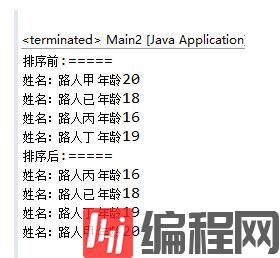这篇文章主要介绍了java如何根据List内对象的属性进行排序,具有一定借鉴价值,感兴趣的朋友可以参考下,希望大家阅读完这篇文章之后大有收获,下面让小编带着大家一起了解一下。
方法一:实现Comparator接口,并重写compare方法
实体类代码:
import java.util.Comparator;public class Student implements Comparator<Student>{ private String name; //姓名 private int age; //年龄 //重写 比较方法 本次例子定义为按年龄比较 @Override public int compare(Student o1, Student o2) { if(o1.getAge() > o2.getAge()){ return 1; }else{ return -1; } } public Student(String name, int age) { super(); this.name = name; this.age = age; } public String getName() { return name; } public void setName(String name) { this.name = name; } public int getAge() { return age; } public void setAge(int age) { this.age = age; }}测试类:
import java.util.ArrayList;import java.util.Collections;import java.util.List;public class Main { public static void main(String[] args) { //初始化四个不同的学生 Student stu1 = new Student("路人甲", 20); Student stu2 = new Student("路人已", 18); Student stu3 = new Student("路人丙", 16); Student stu4 = new Student("路人丁", 19); //新建List把学生加进List List<Student> stuList = new ArrayList<>(); stuList.add(stu1); stuList.add(stu2); stuList.add(stu3); stuList.add(stu4); System.out.println("排序前:====="); for(Student stu :stuList){ System.out.println("姓名:"+stu.getName() +" 年龄"+stu.getAge()); } //排序 Collections.sort(stuList, stu1); //第一个参数为List 第二个参数为对象的一个实例 System.out.println("排序后:====="); for(Student stu :stuList){ System.out.println("姓名:"+stu.getName() +" 年龄"+stu.getAge()); } }}运行结果:

方法二:实现Comparable接口 并重写compareTo方法
public class Student2 implements Comparable<Student2> { private String name; // 姓名 private int age; // 年龄 // 重写 比较方法 本次例子定义为按年龄比较 @Override public int compareTo(Student2 stu) { if (this.age > stu.getAge()) { return 1; } else { return -1; } } public Student2(String name, int age) { super(); this.name = name; this.age = age; } public String getName() { return name; } public void setName(String name) { this.name = name; } public int getAge() { return age; } public void setAge(int age) { this.age = age; }}测试类
import java.util.ArrayList;import java.util.Collections;import java.util.List;public class Main2 { public static void main(String[] args) { //初始化四个不同的学生 Student2 stu1 = new Student2("路人甲", 20); Student2 stu2 = new Student2("路人已", 18); Student2 stu3 = new Student2("路人丙", 16); Student2 stu4 = new Student2("路人丁", 19); //新建List把学生加进List List<Student2> stuList = new ArrayList<>(); stuList.add(stu1); stuList.add(stu2); stuList.add(stu3); stuList.add(stu4); System.out.println("排序前:====="); for(Student2 stu :stuList){ System.out.println("姓名:"+stu.getName() +" 年龄"+stu.getAge()); } //排序 Collections.sort(stuList); //只有一个参数参数为List System.out.println("排序后:====="); for(Student2 stu :stuList){ System.out.println("姓名:"+stu.getName() +" 年龄"+stu.getAge()); } }}运行结果

三、总结:两种方式写法和用法上的区别:

感谢你能够认真阅读完这篇文章,希望小编分享的“java如何根据List内对象的属性进行排序”这篇文章对大家有帮助,同时也希望大家多多支持编程网,关注编程网行业资讯频道,更多相关知识等着你来学习!







